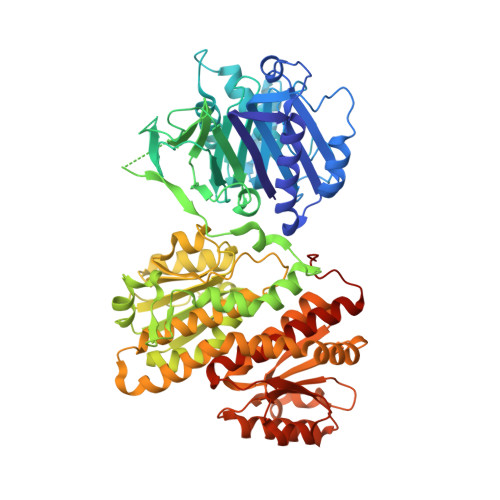Loss of GFAT-1 feedback regulation activates the hexosamine pathway that modulates protein homeostasis.
Ruegenberg, S., Horn, M., Pichlo, C., Allmeroth, K., Baumann, U., Denzel, M.S.(2020) Nat Commun 11: 687-687
- PubMed: 32019926
- DOI: https://doi.org/10.1038/s41467-020-14524-5
- Primary Citation of Related Structures:
6R4E, 6R4F, 6R4G, 6R4H, 6R4I, 6R4J, 6SVM, 6SVO, 6SVP, 6SVQ - PubMed Abstract:
Glutamine fructose-6-phosphate amidotransferase (GFAT) is the key enzyme in the hexosamine pathway (HP) that produces uridine 5'-diphospho-N-acetyl-D-glucosamine (UDP-GlcNAc), linking energy metabolism with posttranslational protein glycosylation. In Caenorhabditis elegans, we previously identified gfat-1 gain-of-function mutations that elevate UDP-GlcNAc levels, improve protein homeostasis, and extend lifespan. GFAT is highly conserved, but the gain-of-function mechanism and its relevance in mammalian cells remained unclear. Here, we present the full-length crystal structure of human GFAT-1 in complex with various ligands and with important mutations. UDP-GlcNAc directly interacts with GFAT-1, inhibiting catalytic activity. The longevity-associated G451E variant shows drastically reduced sensitivity to UDP-GlcNAc inhibition in enzyme activity assays. Our structural and functional data point to a critical role of the interdomain linker in UDP-GlcNAc inhibition. In mammalian cells, the G451E variant potently activates the HP. Therefore, GFAT-1 gain-of-function through loss of feedback inhibition constitutes a potential target for the treatment of age-related proteinopathies.
- Max Planck Institute for Biology of Ageing, 50931, Cologne, Germany.
Organizational Affiliation:




















